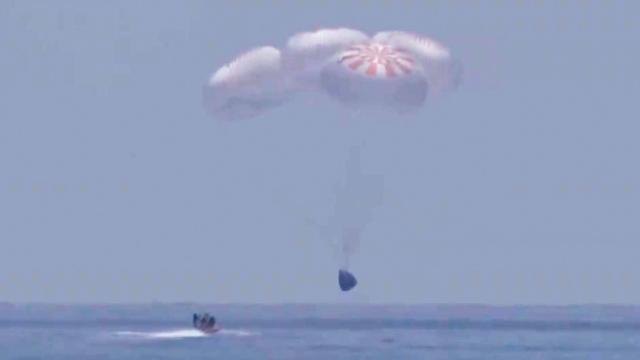SpaceX’s Crew Dragon spacecraft splashed down safely in the Gulf of Mexico shortly before 5 a.m. AEST on Sunday, marking the successful completion of both the first astronaut trip to orbit by a private company and NASA’s first water landing in 45 years. You can check out a clip of the historic moment in a tweet by SpaceX below:
Good splashdown of Dragon confirmed! Welcome back to Earth, @AstroBehnken and @Astro_Doug! pic.twitter.com/0vAS3CcK9P
— SpaceX (@SpaceX) August 2, 2020
NASA astronauts Bob Behnken and Doug Hurley were reported as being in good health shortly after landing, per the New York Times. Hurley asked SpaceX’s mission controllers to tell health professionals waiting on standby that “we’re doing pretty good so far,” immediately after the splashdown.
The two had been aboard the spacecraft — called the Dragon Endeavour — since Saturday evening when it undocked from the International Space Station and manoeuvred away with a series of thruster burns. Shortly afterward, the spacecraft shot out its bottom half, known as the trunk, to reveal a heat shield to protect the capsule and its crew as they reentered orbit. The capsule’s drogue parachutes are designed to deploy at around 18,000, followed by its four main orange-and-white parachutes at about 1,828 metres.
Immediately after the splashdown, two SpaceX boats sped off from the main recovery vessel, called Go Navigator, which was set up about three miles away from the projected landing site, to recover the parachutes and prepare the capsule to be pulled up by the mother ship. At around 6 a.m. AEST, the capsule was opened after being hoisted aboard the Go Navigator, and Behnken followed by Hurley gave triumphant thumb’s ups as they egressed with assistance from NASA’s recovery team.
Weather concerns had SpaceX and NASA slightly on edge leading up to the splashdown, as Hurricane Isaias was expected to approach Florida’s east coast sometime this weekend. NASA hoped the capsule would land near Florida’s western coast, where forecasters predicted calmer waters per CNN. The forecast proved true as the Crew Dragon splashed down near Pensacola at a pace of 24 km per hour.
The astronauts spent 63 days in orbit after launching on a Falcon 9 rocket from NASA’s Kennedy Space Centre in Florida at the end of May, the first launch from American soil in nearly a decade since NASA shuttered its space shuttle program in 2011. The success of this mission — which was technically considered a test flight — paves the way for NASA to officially certify SpaceX’s Crew Dragon as a human-rated space shuttle moving forward.
